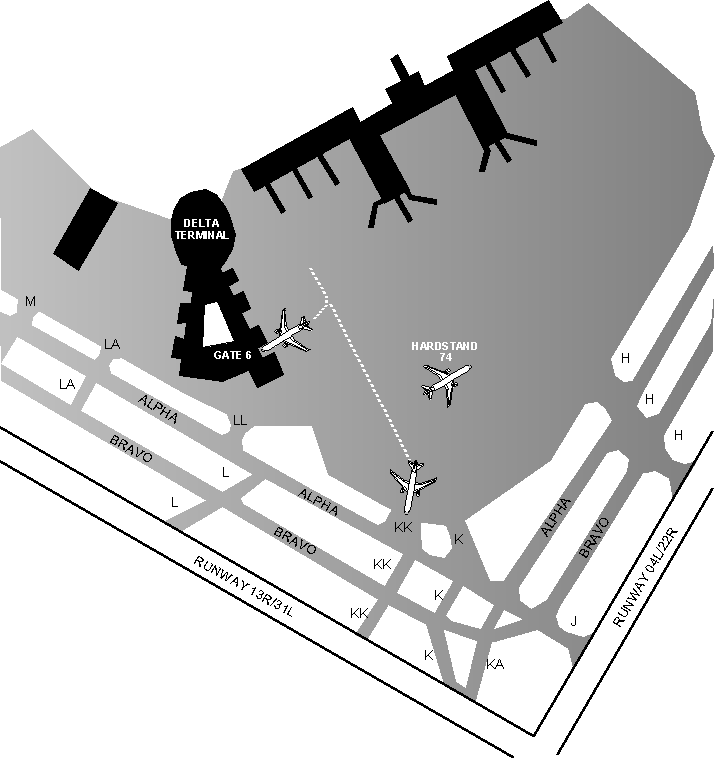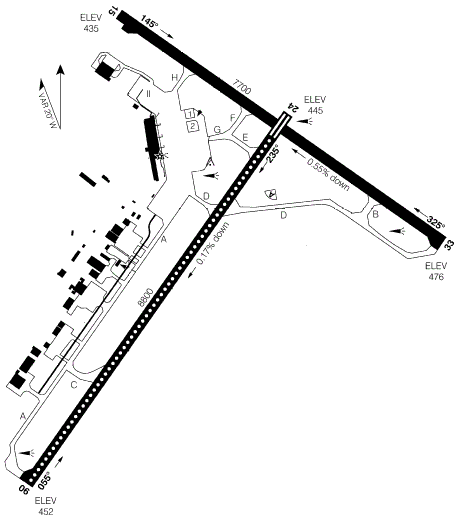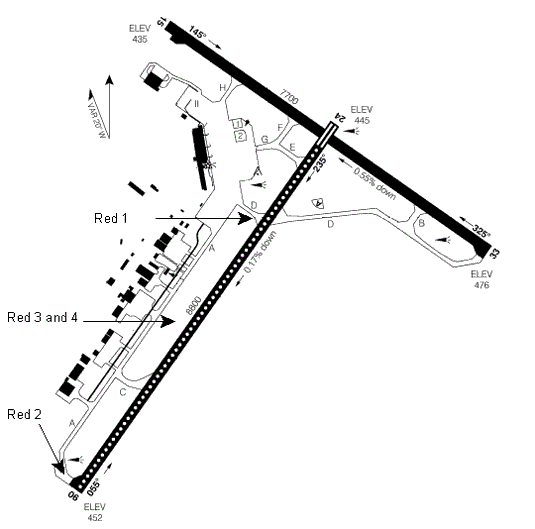Associated links (A98H0003)
-
Table of contents
Aerodromes
JFK Airport
JFK airport is in Jamaica, Queens County, New York, 13 nm southeast of the City of New York. The geographic position of the airport is latitude 40° 38′ 23″ N and longitude 73° 46′ 44″ W, with a field elevation of 13 feet above mean sea level. The airport is owned by the City of New York and operated by the Port Authority of New York and New Jersey. ATC services are provided by an ATC tower at the airport, and radar services are provided by the New York ARTCC. There are two sets of parallel runways: runways 13/31 left and right and runways 04/22 left and right. The magnetic variation for the airport is 13 degrees west. SR 111departed from Runway 13 R, which is 14 572 feet long and 150 feet wide. The runway is constructed of asphalt and concrete.
Ground handling at JFK
On 2 September 1998, the occurrence aircraft, inbound from Zurich, Switzerland, landed at JFK at 1716 and arrived at Gate 6 of Terminal 3, the Delta Airlines Terminal, at 1722. The aircraft was met at the gate by two security guards. One boarded the aircraft from the jetway as the main aircraft door was opened to disembark the passengers, the other was always present on the ramp during the off-loading of cargo and baggage. The security guards were contract personnel with an external security company; however, most of them had been with the company for several years. They were able to contact the base at the airport via a hand-held radio if they needed assistance or relief.
After the passengers disembarked, the on-board security guard inspected the overhead bins, the seats, and other areas of the aircraft to ensure that nothing had been left behind by anyone. A thorough physical search of the aircraft was completed.
Because there are limited gate facilities at JFK and Terminal 3, the aircraft had to be moved from the gate to a hard stand (parking area on the apron) and accessed by portable stairs; the aircraft remained there until a gate was available. The aircraft was towed to parking spot 74.
The security guard remained on board the aircraft until 2200, at which time another security guard relieved the first guard. During the first guard's shift, the aircraft cabin was groomed (cleaned) by approximately 20 cleaners during a period of 45 minutes. The guard was responsible for screening and monitoring personnel boarding the aircraft to perform the grooming. During the second guard's shift, the food for SR 111 was delivered. The second guard remained on board the aircraft as it was towed back to Gate 6 and deplaned when the crew arrived, at which time he stationed himself outside the aircraft door on the jetway until all the passengers had boarded SR 111. The aircraft pushed back from the gate at 2353, taxied from the terminal across the ramp, and exited the ramp via taxiway "KK".
Swissair security procedures at JFK
Any cash being transported on board would have been locked in a sales container and seals put on the locks by the cabin crew. The security personnel verified that the seals were secure. There was no official paperwork involved in this process.
The Port Authority Police were present for the loading and unloading of valuables. Outbound valuables were transported by armoured car from the cargo facility to the aircraft. The valuables were stored at the cargo facility in a bunker. The bunker, presided over by a security guard, has a watch room (a screened-in area, which is locked) and a vault for valuable items.
The security guard signed out valuables, which were loaded onto a transport vehicle. The transport vehicle was escorted by an armed, uniformed guard, and Port Authority Police, who stayed with the cargo until it was loaded.
For inbound flights, ramp security personnel conduct a physical check of the cargo bays and place tape seals over the doors. To do so, they get on top of high loader equipment and look around using a flashlight to ensure that the cargo bays are empty. They also physically check the cargo bays when the aircraft is returned to the gate.
Audits of the security practices at JFK were conducted semi-annually by Swissair quality assurance personnel from Zurich.
Aircraft maintenance at JFK
On the day of the occurrence, when HB-IWF arrived from Zurich, it had only one maintenance write up. The cabin crew complained that the rear lavatory had a bad smell. Maintenance personnel investigated and cleaned the lavatory. One of the maintenance workers noticed that one taxi light on the nose gear had a cracked lens, and it was changed. This maintenance action was not noted in the log book. The maintenance supervisor was informed of the light bulb change after the accident when he came into the office at 0700.
Halifax International Airport
Halifax International Airport, is at latitude 44°52'51" N and longitude 63°30'31" W, with a field reference elevation of 477 feet above mean sea level. The airport was owned and operated by Transport Canada (Government of Canada). There are two landing surfaces: Runway 15/33 and Runway 06/24. The magnetic heading for Runway 06 is 056 degrees. The magnetic variation in the Halifax area is 20 degrees west. Runway 15/33 is 7 700 feet long and 200 feet wide and is constructed of asphalt. Runway 06/24 is 8 800 feet long and 200 feet wide, and is constructed of asphalt and concrete.
Halifax International Airport emergency response
Emergency response requirements for Canadian airports are detailed in the CARs, Part III - Aerodrome and Airports, Subpart 3 - Aircraft Fire Fighting at Airports and Aerodromes. Standards are in Section 323, and Advisory Documents in Section 343 of the CARs.
Halifax International Airport provides Category 8 AFF on a 24-hour basis. To meet this category of response, an airport must have at least three vehicles with a combined total of 18 200 L of water available for the production of aqueous film-forming foam and 450 kg of dry chemical, and must be capable of discharging 7 200 L of liquid per minute.
On the night of the occurrence, Halifax AFF received instructions from the Halifax Control Tower at 0120 on the tower hotline telephone to take standby positions for a landing on Runway 06. Four vehicles responded to the standby summons. Red 1 and Red 2 were Waltec C5500 AFF vehicles, each containing 5 500 L of water, 225 kg of dry chemical and 660 L of foam. Each of these vehicles was fitted with night-sight capabilities and carried standard aircraft rescue tools. Red 1 was the command and control vehicle and contained one firefighter and one fire officer; Red 2 carried one firefighter. Red 3 was an Oshkosh T3000 AFF vehicle containing 11 300 L of water, 225 kg of dry chemical (potassium bicarbonate), and 1 590 L of foam; this vehicle carried one firefighter. Red 4 was a structural pumper carrying 2 250 L of water and 180 L of foam; this vehicle carried two firefighters.
The AFF vehicles were in their standby positions within one minute after call-out. At 0120:43, after being asked by Moncton ACC to have the fire trucks standing by, the Halifax Control Tower responded that they were already in position. Red 2 took up a position at the touchdown area of Runway 06 and held at the holding bay on taxiway "A". Red 3 and 4 responded to an emergency access road at the approximate runway midpoint and Red 1 held on taxiway "D." The AFF stood down at 0155.
The Halifax International Airport AFF is required to and meets the service standards specified in the CARs Part III, Section 323 - Aerodrome and Airport Standards Respecting Aircraft Fire Fighting at Airports and Aerodromes.



